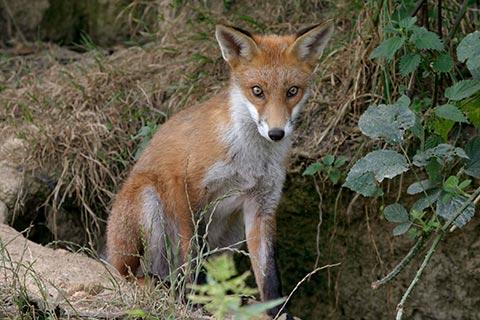Foxes in the garden
Foxes are a common sight in our gardens. Living with foxes is a joy for many people but for some, they present as a problem. Read on to find out more about how you can either encourage or deter foxes humanely from your garden.

Helping foxes in your garden
Foxes are great scavengers. If you see them frequently in your garden you can assume they have already found a good food supply. There shouldn't be a need for any extra.
If you decide to leave food out for foxes, be cautious and never try to make them tame or hand-feed them. Don’t put out too much food, as foxes won’t move far if they can find all the food they need in one place.
You may enjoy seeing foxes in your garden but your neighbours may not! They might bury the extra food, leave droppings or cause other problems in your neighbour's gardens.
Finding a fox den
Foxes will often dig their dens (called 'earths') under sheds or decking, or they might use holes made by other animals. They might have more than one den in their territory, so the mother can move her cubs if she’s been disturbed. If you’re unsure whether a den is being used, then cover part of the entrance with loose soil or sticks. This still allows foxes to come and go but if the soil or sticks haven't moved after a few days, the den should be empty.
Always check before starting to work in your garden near a fox den. If you've planned to demolish or build on top of a den wait until after the cubs have left the den in late summer.
If you can't wait, then start by cutting back plants that have grown around the area to make it less sheltered. Before embarking on work you can encourage the mother fox (vixen) to move on by making noise near the den. You could also start walking around the den.

Deterring foxes
Not everyone's happy to see foxes in their gardens. Here are some suggestions on how to humanely deter them. There's no single solution that works every time, so you'll need to try a combination of these.
Remove access to any food source
- Use bird feeders that stop the food from spilling onto the ground where foxes can eat it.
- Use feeding stations if you leave food on the ground for other wildlife, like hedgehogs, somewhere that foxes can't access.
- Protect fruit or vegetable crops using fences or solid weld-mesh, with holes at least 4cm wide. Don't use flexible netting as there's a risk of wildlife getting tangled or caught in it.
- Promptly clear away fallen fruit from trees.
- Use securely sealed dustbins and composters. You can secure the lids of a dustbin or composter by using a clip-on lid or expanding bungee straps.
- Don't put the rubbish out in plastic bags which foxes can easily break through.
- Keep any pets such as rabbits indoors or in secure enclosures during the night. These enclosures will need a solid roof and floor. Sides should be made from weld-mesh fencing (not chicken wire) and the doors should have a good lock that can't be dislodged. Make sure that you clear up any pet food that spills onto the ground.
- Avoid using garden fertilisers that contain meat, fish, blood or bone products, as this might be encouraging foxes to dig in the garden looking for buried food. Try using plant-based fertilisers instead.
- Talk to your neighbours to check they haven't been feeding the foxes. Ask them to take the same steps as you to help encourage the foxes to move on.
Remove anywhere for shelter
- Cut or clear areas of long grass, weeds or overgrown plants – these can provide a safe, sheltered area for a fox to rest during the day.
- Keep your garage, greenhouse and shed doors closed.
- Block up areas under sheds or decking (autumn and winter is the best time) as these are ideal locations for fox dens. Always check to see if the den is being used first.
Discourage foxes from entering the garden
- Observe where the foxes are entering your garden so you can target those areas.
- Erect fencing or plant prickly plants around the edges of the garden.
- Use an animal repellent approved for use with foxes - these are widely available from garden centres or hardware stores. It's illegal to use any substance to deter foxes that haven't been approved for that use,
Removing foxes from your garden
Some people may be concerned about foxes in their gardens causing noise or damage. We don't capture and remove healthy foxes. This seems like a simple solution, but it can harm the fox and often won't solve the problem. If a fox is moved and released elsewhere this will be in another fox's territory. There's the chance the fox could be attacked by the other fox, and struggle to find food or shelter in an unfamiliar place.
The best solution for you and the fox is to use the non-harmful methods of deterrence described above. If a fox is removed from the garden, but the environment stays the same, then other foxes will move in to take advantage of the empty territory. If you can remove whatever was attracting the fox - such as food sources or shelter - then this fox will leave, and other foxes won't move in.
Dealing with foxes in your garden is your responsibility - there's no legal obligation for local authorities to help with this.
Pesticide poisoning
It's illegal to poison foxes. The government's Wildlife Incident Investigation Scheme looks into the deaths of wildlife where pesticide poisoning may be involved.
If you find a dead fox that you suspect has been poisoned, or find evidence of a pesticide that puts foxes or wildlife at risk, please visit the Scheme's website for further guidance.
Don't touch the dead animal or bait, as some poisons can pass through the skin.
What if a fox comes into my home?
It's rare for foxes to come into our homes as they're wary of people. If it does happen, firstly close all other doors apart from one. Use something with a long handle, such as a broom, to gently encourage the fox towards the door. It's best if only one person does this, and they should stay quiet and calm to help stop the fox from panicking more than necessary.
Are foxes dangerous?
Foxes aren't usually aggressive to people or pets, they will run away unless directly threatened. Foxes can learn to trust people who aren't harming them and become bolder around these people. It's important not to hand-feed foxes, or tame them, as this could encourage them to approach other people who don't want to get close to foxes.
Foxes are most active at night, at dawn or dusk. Foxes will come into gardens during the day when they’re looking for food or somewhere to rest. Foxes call throughout the year, but normally only howl or scream during the mating season, which peaks in January. During this time, it may be worth using earplugs at night if the howling disturbs you.
Foxes and diseases
Foxes can carry some diseases which can pass to people, such as mange or toxoplasmosis (an infection carried through faeces). Pet dogs or cats are the most likely sources of these infections rather than foxes. The risk of catching diseases from foxes is very low unless you're in direct contact with them or their faeces.
Another disease risk is from the roundworm (Toxocara canis) found in dog, cat and fox droppings, which can cause toxocariasis in children. The risk of children picking up this parasite from foxes appears to be extremely low. If you're concerned, remove any fox droppings in your garden while wearing thick gloves, and try using a fox repellent. If you have any concerns about health risks from animals, contact your doctor for advice.
Foxes and cats
Foxes and cats live alongside each other in towns and cities and they're both active at night. The low number of reports of foxes attacking cats shows that most cats aren't at risk from foxes.
Researchers have watched the interaction between foxes and cats using night-vision binoculars. They found the animals either ignored each other, the foxes were chased away or acted nervous around the cats.
Foxes and dogs
Scent is an important part of how foxes communicate. A male fox could follow a female dog in heat but this isn't common. Dogs can pose a real threat to foxes, so a fox will usually avoid dogs. It's possible for dogs to catch mange from foxes, but it's unlikely for dogs to come into close contact with a live fox for the disease to be transmitted.
If you come across a fox carcass, it's important to discourage your dog from getting too close. If you're worried that your dog may be infected with mange, contact your vet for advice as it's easily treated.

